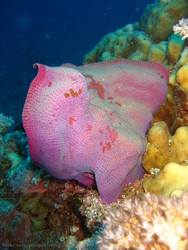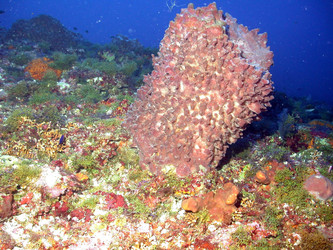The word sponge, for most of us relates to the scrubbing sponge or a bath sponge. It is easy to forget that there is much more to sponges than the scrubbing and bath. The sponges are living animals that live in the water. They are stuck to the floor in the oceans, sea, and rivers. They are known as Porifera. The Poriferans are simple multi cellular animals. There are about 5000 to 10,000 of species of Porifera that are known today. Out of them only 150 species live in fresh water. The rest of the sponges dwell in salt-water. Sponges are very primitive creatures that evolved around 500 million years ago (1). There are many different types of sponges all over the world. Some of these sponges are very colorful and beautiful (1).
- Common Name: Sponges
- Kingdom: Animalia
- Phylum: Porifera
- Classes: Calcarea, Demospongiae, Hexactinellida
Sponges are the first and most simple members of Metazoa in the ancestral lineage of animals (Dawkins 2004). For a long time they were written off as ‘parazoa’. Today the rest of the Metazoans are considered to belong to Eumetazoa. Some molecular taxonomists think that there are two lineages of sponges, one more closely related to other more complex Metazoans than the other.
People often think of sponges as plants, rather than being animals. This misconception is due to some of the characteristics of the Porifera (Dawkins 2004). Like plants they do not move, i.e., they are sessile. They stay put in one place stuck to the bottom of the water- either salt or fresh. Also, they don't have muscles. Like plants they move at the cellular level (Dawkins 2004).
Sponges are multi-cellular. They are known be diploblast, which means having two layers of cells (Dawkins 2004). As an adult they may have multiple cell layers, but initially they all arise from the two layers that were present in the early embryo (Dawkins 2004). Most are sponges are asymmetrical, though some of them exhibit radial symmetry (Dawkins 2004). The typical body form of a sponge consists of a hollow pitcher surrounded by lots of small holes and opens up on the top with a big hole. Sponges do not have a coelom. A coelom is the cavity within the body in which the intestines, lungs, heart, kidney, etc., are located, and it is sealed off from the outside world. The body cavity of sponges is large, it is open to the outside world, and it enables the sponge to consume food (Dawkins 2004). Sponges do not have any internal organs or a nervous system. Their skeleton is made of tiny, needle-like splinters, or a mesh of protein called spongin (2) Most of the Demospongiae are made of spongin. Some of the sponges are made of both spicules and spongin. Bath sponges are made of calcereous or siliceous spicules, and they are therefore soft to the touch. Most of the bath sponges are Demospongiae (2).
Porifera means pore-bearing. Sponges are covered with tiny pores on the outside called ostia (2). Ostia lead to an internal system of canals which leads to one or more larger holes called oscula, which are the openings to the out side. Ostia are surrounded by donut shaped cells called porocytes. The chambers within the canals are lined up with cells called choanocytes, or collar cells. The collar cells consist a sticky funnel shaped collar and a hair-like whip called a flagellum. The collar cells beat their flagella back and forth to force the water through the sponge. The water brings in nutrients and oxygen and takes out the carbon dioxide. The two purposes of providing food and removing wastes are served due to this function. The sticky collars also pick up tiny particles of food and bacteria brought in by the water (2).
Unlike the cells of most other animals, the cells of sponges do not form into various organs like kidney, liver, or nerves. Sponge cells are totipotent (Dawkins 2004). The totipotent cells could give rise to reproductive cells or other types of cells of the organism. In theory, this enables a sponge to live forever (Dawkins 2004).
Sponges can produce sexually as well as asexually. Most sponges are hermaphroditic, which means each adult can act as either female or male. Asexual reproduction happens by budding and fragmentation (4). With this type of reproduction pieces or fragments of the sponge's body are broken off the by the water currents, and they are carried by the currents to a different location. There they attach themselves to the ocean floor and grow to be an adult sponge. Some of the sponges form internal buds, called gemmules. These can survive even extremely unfavorable conditions. They survive even after the rest of the sponge dies due to the unfavorable conditions (4).
Sexual reproduction happens internally. The male acting sponge cells release the gametes into the water. From there the sperm travels closer to the female acting sponge cells, where it is picked up by the female acting sponge’s choanocytes or the collar cells, which then lose their collars and become special amoeba-like cells that carry the spermatazoa to the eggs, and fertilization then takes place (4). The tiny larvae which are the result of fertilization are released into the water. The larvae use their cilia to propel themselves through the water. Eventually they settles down and grow to be an adult sponge. Next time around when they reproduce the sponges may change roles; the sponge that played male could play female and vice versa (4).
The evolution of multi cellular sponges from single-celled protozoa is one of the landmark events in evolution. This is the origin of the Metazoa, or multicellular organisms (Dawkins 2004). An experiment performed by H. V. Wilson of the University of North Carolina was published in the 1907 issue of the Journal of Experimental Zoology (Wilson 1907). He separated the cells of a living sponge by forcing it through a fine sieve. The separated cells were let out onto a saucer containing sea-water. Most of them were single cells. After a while Wilson observed that the cells behaved like individual beings or amoebas. They were crawling on the bottom of the saucer, and they started joining up to form agglomerations of cells. Eventually they grew to become whole new sponges. When Wilson tried to mash up two different species of sponges together, the separated cells mixed only with their own species. They did not mix with the other kind of species. This experiment may shed some light on how multi cellular animals formed initially. The first sponge may have been a colony of protozoans that happened to be together by chance (Dawkins 2004).
Even though the sponges don’t have nerves and muscles, the individual cells can sense and react to the changes in the surrounding environment. The cell layers are loose conglomaration of cells. They are not really tissues as they are unspecialized. The colonial protists called choanoflagellates live in the bottom of ponds and shallow areas. Biologists think that sponge choanocytes are very similar to choanoflagellate cells, and they believe that it is highly likely that sponges arose from choanoflagalllates that lived in late Precambrian seas. Biologists believe that the molecular evidence points to ancient choanoflagallates as close relatives of the ancestor of all animals.





 Go to quick links
Go to quick search
Go to navigation for this section of the ToL site
Go to detailed links for the ToL site
Go to quick links
Go to quick search
Go to navigation for this section of the ToL site
Go to detailed links for the ToL site